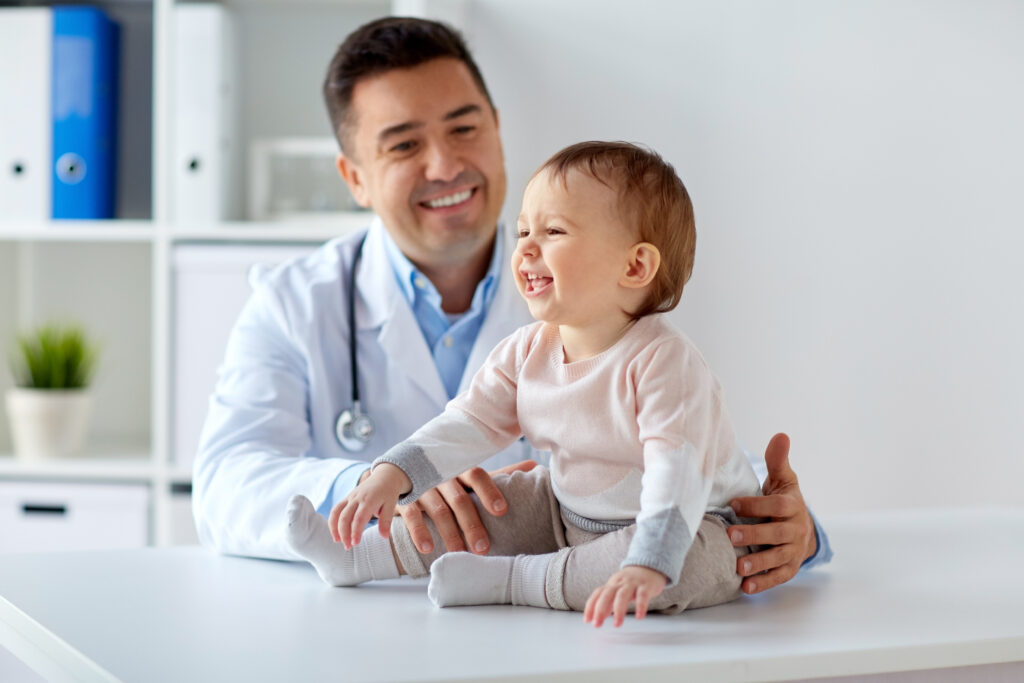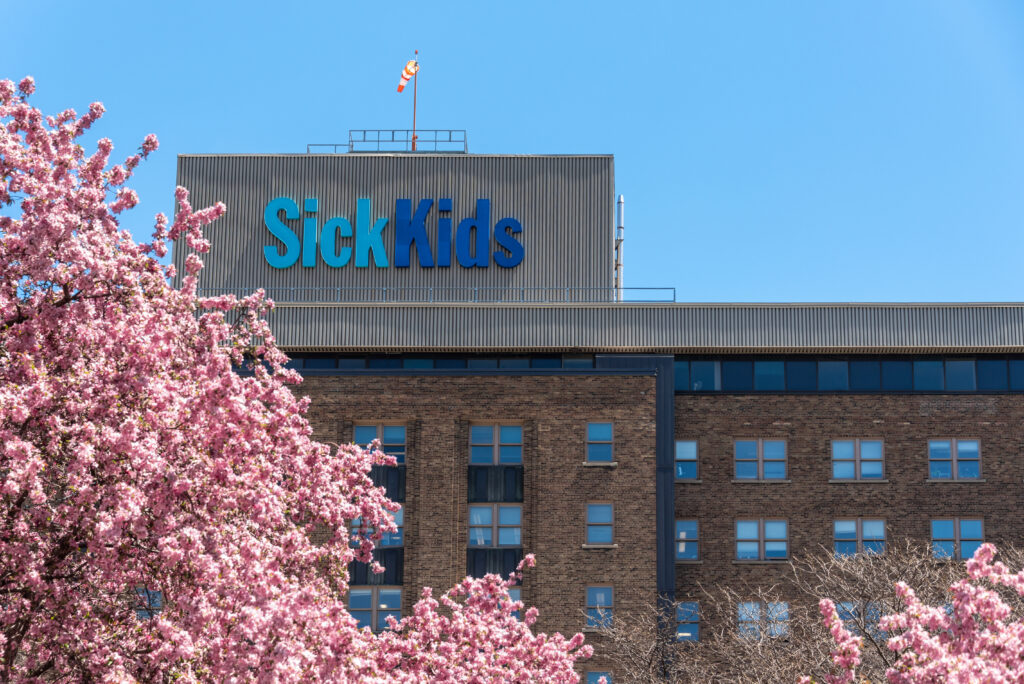OMPRN is honoured to welcome Dr. Grace Egan, a pediatric oncologist at the Hospital for Sick Children in Toronto, SickKids Research Institute and at Princess Margaret Cancer Centre. Dr. Egan has dedicated her career to advancing the treatment and care of children with cancer, combining clinical expertise and compassion. As a mother of two, she brings a unique and deeply personal perspective to her work, understanding both the medical and emotional challenges faced by young patients and their families.
In this interview, we delve into her journey in medicine, pediatric oncology, and her insights on how to support young patients and their families through some of the toughest moments of their lives. Join us as we explore questions related to the challenges and triumphs of this vital medical specialty through the eyes of a true expert.
Interview conducted by Leigh-Ann van Strijp, over email on April 23, 2024.
Download a PDF handout of the interview below:

Dr. Egan, please tell us a bit more about your medical training and where you completed your clinical fellowship.
I completed my medical school training in Ireland, which is where I grew up. I then went on to do my general pediatric training at New York University in New York City, followed by a clinical fellowship in pediatric hematology/oncology at the Hospital for Sick Children [SickKids], Toronto. After this clinical fellowship, I pursued a PhD in molecular biology at Princess Margaret Cancer Centre/University of Toronto.
“Children are so joyful, optimistic, and resilient – helping them (and their parents) through cancer treatments is a privilege and extremely rewarding”.

What made you choose pediatric oncology specifically?
I knew I wanted to practice in a specialty that intertwined patient care with scientific discoveries. During medical school I really enjoyed pediatrics and hematology/oncology rotations, so pursuing a career in pediatric hematology/oncology was an intentional choice for me. I love caring for children and their families. Children are so joyful, optimistic, and resilient – helping them (and their parents) through cancer treatments is a privilege and extremely rewarding.
Working clinically as a pediatric oncologist also motivates me to explore and understand the biology of pediatric cancers, so that we can develop more effective, less toxic, targeted therapies for children with these diseases.
Which pediatric patients do you commonly treat?
At the Hospital for Sick Children, we practice section-based care so I’m largely responsible for treating children who present with leukemias and lymphomas.
Acute lymphoblastic leukemia is the most common disease we see in pediatric oncology, so this group of patients represents a large bulk of the patients that I see and treat. I am also involved in the care of pediatric patients with other leukemias including acute myeloid leukemia (AML) and chronic myeloid leukemia (CML), Hodgkin’s lymphoma (HL) and non-Hodgkin’s lymphoma (NHL), to name a few.
Walk me through a typical day as a pediatric oncologist.
The day of a pediatric oncologist varies depending on where in Canada they are practicing (academic center vs community setting) and how much of their time is devoted to other activities including research, education, and administration.
Clinically, a pediatric oncologist will manage children in the outpatient and inpatient settings. In the outpatient setting, we will manage oncology patients receiving chemotherapy and we will order their chemotherapy, arrange scans or assessments with other providers. We will assess and examine them before, during and after chemotherapy cycles in the clinic. These assessments are important to check blood counts and organ function, check adverse symptoms related to chemotherapy, check growth, nutrition, development, and schooling.

In the inpatient setting we treat newly diagnosed patients, and patients admitted for elective chemotherapy or for complications related to chemotherapy, such as infections, nausea/vomiting, or malnutrition. We will diagnose, assess, and create treatment plans for newly diagnosed children with cancer. We will also manage patients on clinical trials, where new drugs are being tested to see how tolerable they are and what the optimal dosing is (phase I trial) and how effective theses new drugs are in treating specific cancers (phase II and III trials).
Some oncologists also participate in research activities. For these oncologists, some of their time might be spent reading and writing academic papers, writing grants, managing a research team, participating in international consortiums, and developing/running clinical trials. Other oncologists are actively involved in education – these oncologists spend part of their time training the next generation of oncologists and creating curriculums and ensuring oncology training program maintain high standards.
If you would like to read up on the different roles of other specialised oncologists, view the ‘support professionals in cancer care’ page for a breakdown here.
Who are you most thankful for on your care team and why?
On the medical side of things, everyone plays a part in keeping patients safe, ensuring treatment is effective and ensuring patients and their families feel supported and heard. Nurses are key to helping us achieve these goals and are the staff members that families spend most of their time with. In terms of the care team, clinical fellows (experienced doctors in their last few years of training), nurse practitioners and physician assistants are essential for ensuring the day-to-day care of patients is consistent. We also really value our pharmacy colleagues who help us immensely with drug dosing queries, anticipating adverse reactions to chemotherapy and supportive therapy. Dieticians are integral to ensure we stay on top of each child’s nutritional needs. Input from additional allied health professionals is also essential including speech and language therapists, physiotherapists, occupational therapists. We also really value the input from other specialties including infectious disease, the ICU team, radiology, and surgery, to name a few.
In terms of psychosocial care, we rely heavily on our social work team who support families through mental health issues, financial issues, and school issues. The child life team is also vital to ensure the happiness and well being of children on the wards and for children getting medical procedures.
Are there different types of leukemia? If so, what are the major differences?
The two major types of acute leukemia that we see in children and adolescents are acute lymphoblastic leukemia and acute myeloid leukemia. ALL is about 5 times as common as AML and is the most common cancer in children.
These two diseases are treated differently. We know a lot more about ALL, than AML, because it is more common in children. Most of ALL treatment occurs as an outpatient, while AML treatment is shorter, more intense, and predominately occurs in the inpatient setting.
Could you name one or two significant biomarkers that you test for when diagnosing leukemia and how they are tested.
For pediatric ALL, the white cell count at diagnosis is a prognostic marker (insert link to SM post on prognostic biomarkers)that can indicate more aggressive disease when it is higher than 50. Age is also a biomarker in ALL treatment, as children that are less than 1 year old or over 10 years old at diagnosis, in general have less optimal outcomes. We use age and presenting white blood cell count (in addition to several other genetic markers) to risk stratify to standard risk (less intensive) vs high risk (more intensive chemotherapy). The presence of leukemia cells in the spinal fluid is also a biomarker of more invasive disease, which requires more intense therapy. The amount of leukemia left in the bone marrow at the end of an induction block of leukemia (termed minimal residual disease) is another biomarker that we use to stratify patients to the appropriate treatment.
For pediatric AML, we have less biomarkers because the disease is heterogenous and is much less common, so we know less about it. Recently, we have begun to use minimal residual disease testing (in addition to a more complex risk stratification approach based on genetic markers), to risk stratify AML patients to intensive chemotherapy versus intensive chemotherapy plus bone marrow transplant.
Take a look at our biomarker’s storybook as well as our ‘understanding biomarkers’ resource for a more comprehensive view of biomarkers.
Does SickKids offer support for the child or families in terms of counselling or mental health support?
At the time of diagnosis, every child and family are connected with a core team which includes a Pediatric Oncologist, a Clinical Program Nurse Coordinator, and a Social Worker. Social workers meet with every family and offer extensive support from diagnosis through treatment completion. Social workers within the Oncology division practice section based care – so for example, within the Leukemia/Lymphoma division, there is a team of consistent social workers who specialize in coordinating services for children with leukemias and lymphomas. This section-based approach helps ensure our social workers understand the needs and challenges of each patient and family. Social workers promote resilience, enhance coping and build strong therapeutic relationships with our families. SickKids social workers conduct evidence-informed clinical psychosocial assessments and provide crisis, supportive, adjustment, resource, and bereavement counseling. They also help families work through financial and employment issues, coping strategies, and mental health challenges that arise through the cancer journey.

For some patients, the pediatric advanced care team (PACT) also provides an extra layer of support. The PACT team are a group of health-care providers, including physicians, nurses and grief support coordinators, that specialize in optimizing quality of life for a child and their whole family. They do this this by maximizing things that bring joy to a child’s life, while helping to mitigate the challenges that go along with a serious illness.
Should pediatric oncology patients and their families be seeking a second opinion from another hospital or doctor?
This is an excellent question, and the answer can be different for every patient and every family. For patients with a relatively straight-forward diagnosis, it is likely not necessary. A “straight forward” diagnosis is one where the cancer presents in a common manner and genetic testing indicates that a common genetic marker is identified in the patient’s cancer cells. If the patient then responds to chemotherapy and the disease goes into remission, a second opinion is generally not required.
If the patient’s cancer is more complex, for example, the cancer presents at a usual age or in an unusual place, or if the genetic abnormalities in the cancer are unusual or have never been reported before, further discussion with other oncologists usually occurs to come up with the best treatment plan for the patient. If the patient’s cancer does not go into remission after induction chemotherapy, this represents another time for physicians to discuss treatment options with other oncologists.
It is also important to note that as oncologists, we are never working in isolation. For example, at SickKids all patients with newly diagnosed leukemias and lymphomas are discussed weekly during multidisciplinary rounds where members of the care team can weigh in and discuss their opinion on work up and treatment plan. This also happens for patients with solid tumors managed under the solid tumor team, patients with brain tumors under the neuro-oncology team and for patients receiving a bone marrow transplant under the bone marrow transplant team. For smaller centers, oncologists will still do this. Smaller centers will also sometimes contact more specialized centers, like SickKids, to discuss complex patients and illicit additional input from oncology colleagues. In addition, for extremely rare cases, we will oftentimes reach out to international colleagues to elicit expertise and experience.
How do the doctors keep up with the changes in treatment for pediatric oncology?
Things change quickly and the pace with which scientific advances are discovered is increasing. To keep as up to date as possible, while also managing patients clinically, many centers will have oncologists who specialize in specific diseases. Oncologists have clinical expertise to treat a range of different cancers, but they may have extra training in a specific disease.
For example, at SickKids I am involved in the treatment of children with a range of diseases from ALL to Hodgkin’s Lymphoma. I have advanced expertise in childhood acute myeloid leukemia biology and treatment. Many of the oncologists in our division, function like this and have areas of interest which are their “super-specialty”. That way when a patient has an unusual disease or diagnosis or doesn’t respond well to therapy, within our division, we can draw on the collective, advanced expertise of our group.
In addition to this, most oncologists frequently attend scientific meetings where updates are shared on new treatments. Most pediatric oncology centers in Canada also participate in the Children’s Oncology Group (COG) which is an international research group that conducts clinical trials for children with cancer. More than 200 hospitals in North America, Australia, New Zealand, and Europe are members of COG. Through biannual COG meetings, we are kept up to date on cutting edge biologic findings and new treatments for children with cancer.

How will I know if my child qualifies for any of these new treatments as they become available?
Regarding knowing whether a child qualifies for a new treatment, the patient’s oncologist will advise the family. When treatments are very new or have just been tested in the laboratory, a clinical trial will be performed to ensure the treatment is safe and effective. Many large oncology centers run clinical trials. If a child presents with a disease where we have an open clinical trial, we will discuss the option to enroll on the clinical trial at the time of diagnosis. Depending on the trial, the patient will be randomized to the new treatment or to standard therapy. Standard therapy is treatment that most cancer doctors would recommend, and that the patient would otherwise receive if they were not enrolled on a clinical trial.
For a new treatment to become “standard therapy” several criteria must be filled. The major criteria include 1) The new treatment needs to be safe and tolerable 2) Clinicians need to see published results that the new treatment is more effective than “standard therapy” 3) The new treatment needs to be available in Canada.
View our ‘clinical trials’ video for more information on the ins and outs of clinical trials.
Is participating in clinical trials always the best option or should we stick with the regular roadmap laid out after years of treating other children?
There are pros and cons for clinical trials and the decision to participate in a trial is personal to each patient – because every patient has different disease, and every family has different needs. Clinical trials are not always open for every disease. When a trial is not open, a patient will be treated with the “standard of care” or “standard therapy”. As mentioned above, standard therapy is treatment that most cancer doctors would recommend and that the patient would otherwise receive for their cancer, if they decide not to participate in a clinical trial.
Enrolling on a clinical trial is not a guarantee that your child will have a better outcome or will receive a better treatment. A clinical trial is a very educated guess that a new treatment will be more efficacious or less toxic than the current standard of care. While we may have preliminary evidence that the newer treatment is effective, we need to study it in larger studies to confirm. The confirmation of which treatment is better oftentimes takes many years to determine for large trials. For most large phase III trials, a patient will be randomized to the standard of care or the new treatment, and we do not know before enrollment which treatment the patient will receive. This is important for families to understand.
For patients with more rare diseases, the clinical trial may be smaller and there may not be a randomization to the standard of care arm. For patients with rare diseases that historically have bad outcomes, a clinical trial may be the best option for this patient. Ultimately, it is a very individualized decision – one that the patient’s oncologist will discuss with the family, the larger care team and the patient.
Conclusion
We are grateful for Dr. Grace Egan’s insights, which shed light on multifaceted care provided to pediatric oncology patients and their families. Her commitment to advancing treatment through clinical practice and research exemplifies the dedication of professionals at institutions like SickKids and the Princess Margaret Cancer Centre. This interview also highlights the critical support systems in place for young patients and their families, underscoring the importance of a collaborative, comprehensive approach to cancer treatment. We hope this conversation with Dr. Egan offers valuable information and reassurance to families navigating the challenges associated with pediatric cancer.
Become a Member
OMPRN connects pathologists and molecular pathology researchers across Ontario. Become a member to access exclusive research, educational and networking resources.
OMPRN’s patient resources
OMPRN aims to meet the education needs of everyone, from budding researchers to patients and members of the greater patient community.


